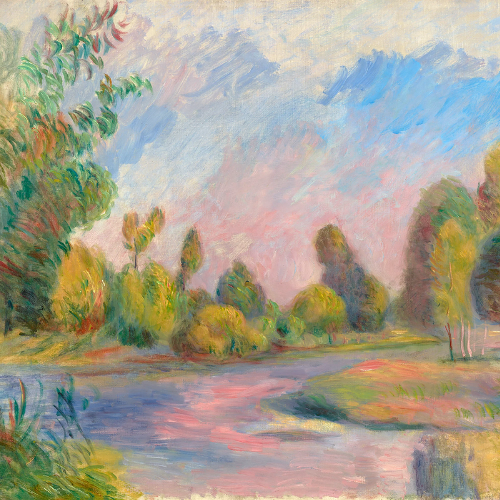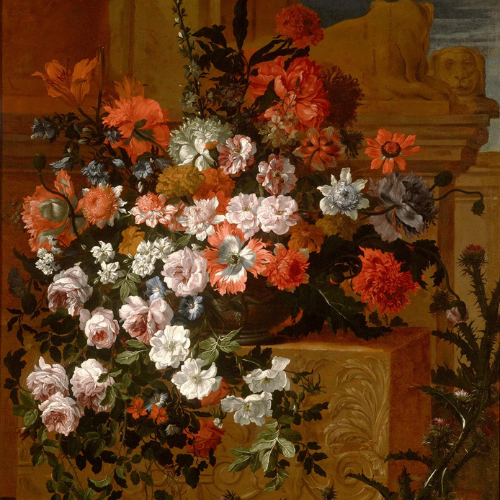“Never put anything on your canvas that isn't of use, never use a detail unless it means something.” –George Inness
George Inness is regarded among America's greatest landscape painters. Initially influenced by the Hudson River School of artists, during the 1850s he traveled to France on numerous occasions admiring the French Barbizon School and their naturalistic style of depicting landscapes. Inness’ meticulous attention to detail, combined with the realistic vision he obtained from the Hudson River and Barbizon Schools, gave way to a style solely attributed to his paintings. Ultimately, he became one of the most important and popular artist-philosophers of his generation.

Early Life and Education
Born in Newburgh, New York, in 1825, Inness was one of 13 children born into a farming family. They moved from the family farm when he was just five years old, settling in Newark, New Jersey. At the age of 14, Inness was established by his father as the proprietor and owner of a small grocery store at the corner of Washington and New Streets in Newark. Yet, rather than attend to his customers, the young Inness concealed his artist materials behind the counter — clearly, his interest lay in more artistic pursuits. His father, realizing that his son was determined to be an artist, placed him under the instruction of John Jesse Barker, a teacher of painting and drawing in Newark.
While Barker’s teachings were foundational and important, Inness gained most of his insight into composition and structure through his study of the landscapes of the Old Masters. In his teens, he moved to New York City in order to work as a map engraver, and would later attend courses at the National Academy of Design beginning in the mid-1840s. It was at this time when he encountered the the works of the Hudson River School painters for the first time, and particularly fell under the influence of Thomas Cole and Asher Durand. The work of the two artists would have a profound effect on the early style of the young Inness.

Summer Landscape, White Mountains by George Inness. Circa 1850
Hudson River School Influence
The rise of a native school of landscape painting in New York in the mid-19th century was one of the most important developments in the relatively short cultural history of the United States. Not only did it signal an important maturation in the field of art, but it also made manifest a number of ideals that were deeply held by the American people of the period.
Known as the Hudson River School, this movement embraced the landscape as a meaningful subject at the same moment when industrialization began to reshape the environment. While their panoramic views often held up a romantic vision that humanity and nature can exist together, some of these works expressed skepticism about the advances of the American empire. Simultaneously championing American progress while also lamenting the loss of the unspoiled wilderness, artists such as Thomas Cole, Albert Bierstadt and Frederic Edwin Church created works that were both picturesque and patriotic. The result was the first truly American style of art.
Inness’ early work is very much in line with the aesthetics and techniques of the Hudson River School. Like them, he was dedicated to the technical meticulousness and purity of direct observation of the landscape. He studied nature profoundly, and his sketches attracted attention when he worked out of doors. His work with the Hudson River School earned him a degree of critical success, and he exhibited at the National Academy and the American Art Union in 1847, 1848 and 1849. Yet, Inness eventually shook himself free of this technical eye, largely thanks to his encounters with artists abroad in the 1850s.

By the Lake by Georges Inness. Dated 1865
Travels Abroad and the Barbizon School
In 1851 Inness and his wife went abroad, thanks to the patronage of Ogden Haggerty, a New York entrepreneur who became Inness’ first patron. The artist spent nearly two years in eager and intensive study during the trip around Europe. Of the countries he visited, Italy seems to have impressed and inspired him most, particularly the works of Claude Lorrain and Salvator Rosa. The classical associations to antiquity and the general atmosphere of romanticism that was so much a part of Italian landscape painting undoubtedly made an impact on the development of Inness’ own style.
On his return to New York, Inness passed through Paris in order to attend the Salon. It was there that, for the first time, he encountered the landscape paintings of the Barbizon School, including Théodore Rousseau. M.S. Rau’s collection of fine art landscape paintings features works by renowned artists who drew inspiration from the Barbizon School.
The Barbizon School, so named because they worked in the area of the French town of Barbizon south of Paris, arose in the context of the Romantic movement of the early 19th century. Part of a general movement towards Naturalism, these artists, including Jean-Baptiste-Camille Corot, Jean-François Millet and Rousseau, are largely responsible for elevating landscape painting to the same degree of importance as history painting in the eyes of the French Academy — and, by extension, the world. Landscapes were no longer a subservient subject, but regarded as masterpieces in their own right.
The passion of the Barbizon painters for painting en plein air not only greatly influenced American landscape painters, but also the generation of Impressionist painters who followed them. It is little wonder that Inness gained such great inspiration from their works — their dedication to nature and poetic response to the landscape resonated deeply with the artist. At the end of his sojourn in Paris, Inness developed the realization that nature was not merely surface, but possessed a spirituality that was worth searching for and putting down on canvas.

Frosty Morning, Montclair by George Inness. Dated 1885
Mature Period
After his return from his European travels, Inness and his new style deviated from the Hudson River School for good. In the words of Inness scholar LeRoy Ireland, “Where Cole and the rest glorified the grandiose aspects of nature, Inness searched for the intimate, the lyrical and the poetic, with all the sensitivity of his being; even in his large-scale canvases there is still this feeling of intimacy.”
It was also during this period when American patrons began to take notice of the landscape painter. Popular art critics suddenly labelled him an innovator and a master of the American landscape, while important collectors, museums and dealers all clamored to own one of his paintings. The critique and popular acclaim would ensure that the artist was financially secure for the rest of his life, allowing him a degree of artistic expression and experimentation enjoyed by few artists of the period.
In the spring of 1870, the artist and his family again sailed for Europe, where Inness painted in Italy and France until 1875. When he returned to the States, he finally settled in Montclair, New Jersey, where he would compose some of his most profound and important masterpieces. Rendered with fresh, loose brushwork and an overt emotional tenor that is reminiscent of the French Barbizon School, Inness’ Montclair landscapes are the true measure of this extraordinary painter.

The Mill Stream, Montclair, New Jersey by George Inness. Circa 1888 (Minneapolis Institute of Art)
Later Life and Death
Once settled in Montclair, Inness constructed a studio at his estate, and it was there where he would compose many of his latter works. Rather than working en plein air, Inness frequently worked from memory later in life, as well as from his sketches from his visits abroad. He would visit Europe one final time in his life, though it would prove to be his last. On August 3, 1894, while admiring a beautiful sunset in the little town of Bridge-of-Allan in Scotland, he was stricken and died suddenly at the age of 69. According to his son, his last words while viewing the setting sun were, “My God! Oh, how beautiful!”
Today, works by this highly respected and admired 19th-century American painter can be found in museum collections around the world. His mesmerizing compositions were created from a thorough knowledge and deep respect for his subject matter: nature. His genuine love of the natural world was reflected throughout his life and in his work, which remains highly prized.
References:
Ireland, LeRoy. The Works of George Inness: An Illustrated Catalogue Raisonné. University of Texas Press, 1965.
"George Inness (1825–1894)" Metmuseum.org. Accessed August 30, 2019. https://www.metmuseum.org/toah/hd/inne/hd_inne.htm.







